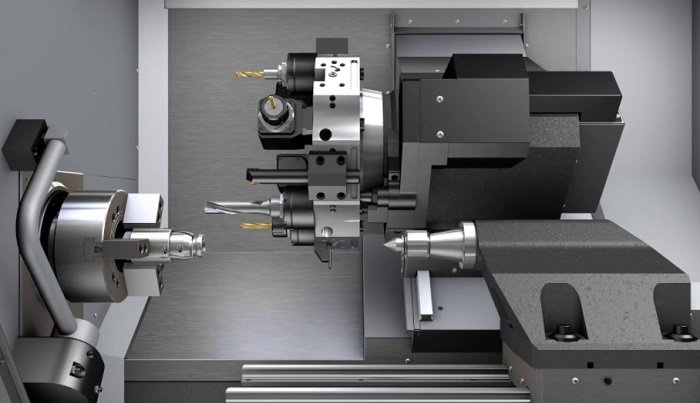7 Tips to Increase Productivity in CNC Metal Lathe Services

CNC metal lathe machining has transformed the manufacturing industry by offering unparalleled precision, consistency, and efficiency in producing complex metal parts. However, as demand increases and competition grows, simply using CNC lathes is no longer enough. You must find ways to continuously improve their productivity. Optimizing processes, using advanced tools, and leveraging new technologies will help you remain competitive and ensure cost-effective operations.
But how can you achieve this? We have seven comprehensive tips that can help you boost productivity in CNC lathe services. Implementing these strategies will help you maximize output, minimize waste, and ensure high-quality results, all while keeping operational costs down. Without wasting more time, let’s get to it.
What Is CNC Metal Lathe Machining?
CNC metal lathe machining is a highly efficient manufacturing process used to shape metal workpieces by removing material through precise, computer-guided cutting. The process begins with a raw metal workpiece, which is securely clamped onto the lathe’s spindle. As the spindle rotates the workpiece at high speeds, the cutting tool removes material according to the programmed instructions.
CNC metal lathe machining process
CNC metal lathes work by following pre-programmed sequences set in a CAD (Computer-Aided Design) or CAM (Computer-Aided Manufacturing) software. These programs control every movement of the machine, dictating the tool’s path, the speed of the spindle, the depth of the cuts, and the feed rate.
CNC metal lathes can perform many machining operations, such as turning, facing, drilling, boring, and threading. They are useful for producing cylindrical parts like shafts, screws, and bushings. With technological advancements, they can handle increasingly complex geometries, making them indispensable in various industries.
How to Boost Productivity in CNC Metal Lathe Services
To maximize the potential of CNC metal lathes, you need to adopt strategies beyond simply running machines. Increasing productivity involves refining processes, adopting new technologies, and ensuring that machines operate efficiently. Below are seven tips that can help you significantly enhance productivity in your CNC lathe service for metal.
1. Optimize Tooling Selection and Maintenance
Tooling is one of the most important aspects of any CNC metal lathe operation. The cutting tools you choose and how well they are maintained can directly impact both productivity and the quality of the finished product. Using the most suitable tool for the job ensures faster cutting speeds, better surface finishes, and longer tool life.
Tool selection in CNC lathe machining
Different metals have different hardness levels, requiring specific types of cutting tools. For example, carbide and ceramic tools are ideal for hard metals like steel because they offer superior wear resistance. Conversely, high-speed steel tools may be more suited for softer metals like aluminum. Furthermore, tools with advanced coatings like titanium nitride (TiN) or aluminum oxide (Al₂O₃) can improve cutting performance by reducing friction and increasing tool longevity.
Regular tool maintenance is equally essential. Dull tools result in slower machining times, increased friction, and a higher likelihood of producing poor-quality parts. To avoid these issues, it’s important to establish a routine for inspecting and replacing cutting tools before they become inefficient. Automated tool changers (ATCs) can further enhance productivity by reducing downtime for manual tool changes during operation.
2. Improve Workholding Efficiency
Workholding refers to how a workpiece is secured in the lathe during machining. Proper workholding helps achieve precision and ensures that parts are machined accurately without excess vibration or movement. When parts are not firmly held in place, it can lead to errors, poor-quality finishes, and longer cycle times.
One way to improve workholding efficiency is using custom fixtures designed for specific parts. Custom fixtures reduce the need for multiple setups and make it easier to machine complex parts in a single operation, which saves time and improves accuracy. In cases where custom fixtures are impractical, universal workholding solutions like collets or chucks can also offer flexibility and speed during part changes.
Another important consideration is minimizing changeovers between different workpieces. The fewer setups you need, the more continuous your machining process will be. Operators can reduce downtime between jobs by using modular workholding systems that allow quick adjustments.
3. Leverage CAD/CAM Software for Toolpath Optimization
CAD/CAM software are essential in modern CNC machining by generating toolpaths that guide the cutting tools during the machining process. Optimizing these toolpaths can significantly reduce cycle times and enhance the overall efficiency of CNC metal lathe operations.
One way to increase productivity is using the simulation features available in most CAD/CAM software packages. By simulating the machining process before running it on the actual machine, operators can identify potential issues, such as tool collisions or inefficient tool movements, and correct them before production begins. This reduces trial and error, saving both time and materials.
Additionally, advanced toolpath strategies like high-speed machining (HSM) can improve the material removal rate and reduce the amount of time the tool spends cutting. These techniques also help extend tool life by minimizing heat buildup during cutting.
4. Enhance Machine Maintenance and Calibration
CNC lathes are complex machines and they have many moving parts, and keeping them in optimal condition is essential for maintaining high productivity levels. Regular machine maintenance helps prevent unexpected breakdowns, reduces downtime, and ensures that parts are machined to the required specifications.
To enhance productivity, create a maintenance schedule that includes routine checks on lubrication, spindle condition, tool alignment, and coolant levels. Lubricating the machine’s components regularly reduces friction, preventing wear and extending the machine’s lifespan. Equally important is checking the condition of the spindle, which is critical for accurate cutting. Worn spindles can lead to vibrations that affect the precision of the cut.
Calibration is another key factor in ensuring your CNC lathe performs consistently. Over time, even slight deviations in machine alignment can result in errors, which leads to higher scrap rates and longer cycle times. Frequent calibration ensures the machine’s axes and cutting tools are perfectly aligned, minimizing waste and improving overall productivity.
5. Implement Automation and Robotics
Automation has become a game-changer in the CNC machining industry. It allows businesses to streamline operations, reduce manual intervention, and significantly increase productivity. Implementing automation in CNC metal lathe services can take many forms, from automated tool changers to robotic arms that handle the loading and unloading of workpieces.
Robotic arm in CNC metal lathe services
Robotic automation is beneficial in high-volume production environments where continuous operation is required. By using robotic arms to load and unload parts, manufacturers can run machines 24/7 with minimal human intervention. This increases output and ensures more consistent quality, as these robots can perform different repetitive tasks with greater accuracy than humans.
Automated tool changers (ATCs) are another excellent investment for increasing productivity. ATCs allow machines to automatically switch between different cutting tools without an operator manually changing them, reducing downtime and speeding up the machining process.
6. Optimize Cutting Speeds and Feeds
Running a CNC lathe machine too slowly can waste time, and running it too fast can result in poor surface finishes or even damage to the cutting tools. Optimizing cutting speeds and feeds requires a careful balance. Matching the speed and feed rate to the material being machined is essential. For instance, harder metals like steel require slower cutting speeds to avoid overheating, while softer metals like aluminum can be machined at higher speeds without compromising tool life.
Experimenting with different parameters can also yield productivity gains. Sometimes, small adjustments in speed or feed rate can significantly reduce cycle times. Additionally, advanced cutting techniques like high-speed machining can increase the material removal rate. This allows for faster production without sacrificing quality.
7. Train and Empower Your Workforce
Even with the most advanced CNC machinery, having a skilled workforce is critical to maximizing productivity. Operators who are well-trained in using CNC lathes and the latest technologies can spot issues quickly, suggest improvements, and optimize the machining process for better results.
Investing in regular training sessions keeps your team up-to-date on new tools, software, and machining techniques. Training also empowers operators to take a proactive role in maintaining machines and improving processes. For example, operators who understand tool wear patterns can provide valuable input on when to replace or sharpen cutting tools. It will help reduce downtime and enhance productivity.
Remember always to foster a culture of continuous improvement within the workforce and encourage operators to collaborate and share insights on streamlining operations. Engaging your team in this way will boost morale and lead to long-term gains in productivity and efficiency.
Conclusion
Maximizing productivity in CNC metal lathe services requires the right tools, optimized processes, and a skilled workforce. These seven tips can help you improve the efficiency of your CNC operations, reduce costs, and deliver high-quality parts faster.
Remember, productivity is more than just speeding up processes—it’s about working smarter. Implementing these strategies will ensure you stay competitive in the ever-evolving world of CNC machining and meet the demands of your clients with precision and efficiency.
Read More: Car Customization Basics: How You Can Transform Your Ride












